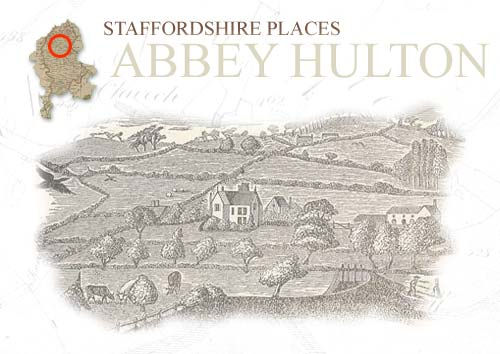Hulton Abbey to Ruston
Grange
Abbey Hulton

Abbey Hulton
Abbey Hulton takes its name
from the former Hulton Abbey, which was located about half a mile from
Milton, on the east side of the road from Stoke to Leek, next to
Carmountside Primary School. In the Domesday Book, Hulton is recorded as
‘Heltone’ meaning ‘hill town’
The abbey, dedicated to St Mary, belonged to the
Cistercian order, the White Monks. It was founded in 1223 by Henry de
Audley in what was then a remote part of the county, in keeping with the
traditional kind of site which the Cistercians chose for their religious
houses. The Audleys continued to be benefactors of the abbey during the
Middle Ages, although it was always poor with only ever a small number of
monks. Following the economic pattern of the Cistercians, the monks of
Hulton Abbey were engaged in sheep farming and they had sheepfolds at
Normacot and at Mixon in the middle of the 13th century, as well as
granges at Hulton and Rushton in Burslem. They were also producing tiles
at Hulton in the 14th century.
Sir James de Audley, who was notable for how courageously he fought under
the Black Prince at the Battle of Poitiers in 1356, was buried in the
choir of the abbey church in front of the high altar with his wife. There
is a tradition that, when the abbey church was demolished and the tombs
opened, the lady’s hair had continued to grow luxuriantly. Hulton Abbey
was surrendered to the Crown on 18th September 1538 by which time it was
worth only £200 per year and had only nine monks including the abbot. It
was always one of the poorest of Staffordshire’s monasteries.
The abbey site and its lands were sold to Sir Edward
Aston of Tixall, near Stafford, in 1543. He later sold to the Sneyds of
Keele in the early 17th century. Excavations of the abbey site took place
in 1884 and again in the early 1930s. Stone from the abbey complex was
used in a number of buildings in the vicinity, including Abbey Farm. A
manor house at Hulton is shown on the map, which accompanies Dr Robert
Plot’s ‘Natural History of Staffordshire’ published in 1686. In the hearth
tax returns of 1666, 30 houses are listed, a little different to the Abbey
Hulton of today.
It was the Housing Act of
1919, which was to transform the area. This facilitated the beginnings of
much-needed housing development in many parts of Stoke on Trent, including
Abbey Hulton, which helped to re-house families from Burslem, and later in
the 1930s from Hanley, under slum clearance programmes. In 1922 Abbey
Hulton became officially part of the County Borough of Stoke on Trent.
Originally part of Burslem ecclesiastical parish, Abbey Hulton now has its
own church, St John’s, built in 1963.
© Staffordshire Past Tracks
  
next: the trackway
to Ruston
previous: remains of the Abbey
|